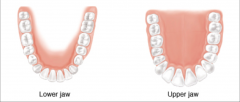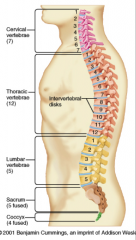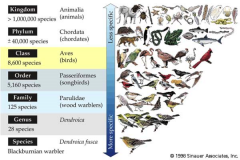![]()
![]()
![]()
Use LEFT and RIGHT arrow keys to navigate between flashcards;
Use UP and DOWN arrow keys to flip the card;
H to show hint;
A reads text to speech;
40 Cards in this Set
- Front
- Back
|
Why do we have bones?
|
Support
Protection Movement Storage and Blood Cell Formation |
|
|
How much do bones weigh?
|
14% of body weight
|
|
|
Different types of bone?
|
Cortex
Cancellous Medullary Cavity |
|
|
Organic Bone
|
Collagen (protein)
|
|
|
Inorganic
|
Hydroxyapatite (mineral)
|
|
|
Axial Skeleton
|
80 Bones
Skull Spine Ribs and Sternum |
|
|
Skull
|
22 Bones
Protects Brain Houses and protects sense organs |
|
|
Appendicular Skeleton
|
Arms
Hips Thighs Legs Feet |
|
|
Adult Dentition
|

2.1.2.3: 2 incisors
1 canine 2 premolars 3 molars |
|
|
Child Teeth
|

2 incisors
1 canine 2 molars |
|
|
Vertebral Column
|

24 non-fused; 9 fused
Protect spinal cord Attachment for muscles Shock absorption |
|
|
Age Estimation Techniques in Children
|
Tooth eruption
Bone growth Cranial suture closure |
|
|
Age Estimation Techniques in Adults
|
Cranial suture closure
Tooth wear Pubic symphysis stage |
|
|
Tooth Eruption
|

|
|
|
Why Classify?
|
To identify objects
Because new species and fossils are discovered |
|
|
Taxonomy
|
Grouping species into larger categories that share biological similarities.
|
|
|
Genus
|
refers to a small group of organisms similar to each other.
|
|
|
Species
|
refers to one group of interbreeding organisms
|
|
|
Biological Taxonomic System
|
Kingdom
Phylum Class Order Family Genus Species |
|
|
Classification Chart
|

|
|
|
Chordata
|
nerve cord
gill slit supporting cord along the back |
|
|
Vertebrates
|
vertebral column
developed brain paired sensory structures for sight, smell, and balance |
|
|
Classes of Vertebrates
|
Jawless Fish
Cartilaginous fish Bony fish Amphibians Reptile Birds Mammals |
|
|
Homologies
|

similarities based on descent from a common ancestor.
|
|
|
Analogies
|
similarities based on common function, with no assumed common evolutionary descent.
|
|
|
Homoplasy
|
the separate evolutionary development of similar characteristics in different groups of organisms.
|
|
|
Ancestral Characters
|
characters inherited by a group of organisms from a remote ancestor. Not diagnostic of groups that diverged after the character first appeared.
|
|
|
Derived characters
|
characters that are modified from the ancestral condition. Thus diagnostic of particular lineages.
|
|
|
Evolutionary Systematics
|
presumed ancestors and descendants are traced in time by analysis of homologous characters.
|
|
|
Cladistics
|
based solely on analysis of certain types of homologous characters.
|
|
|
Biological Species Concept
|
groups of individuals capable of interbreeding, but reproductively isolated from other such groups.
|
|
|
Ecological Species Concept
|
group of organisms exploiting a single niche, emphasizes the role of natural selection in separating species from one another.
|
|
|
Recognition Species Concept
|
groups of individuals with the ability to identify members of their own species for purposes of mating.
|
|
|
Phylogenetic Species Concept
|
species based on an identifiable parental pattern of ancestry. Uses phenotypic and/or genotypic characteristics.
|
|
|
Speciation
|
process by which a new species evolves from a prior species. The most basic process in macroevolution
|
|
|
Allopatric Speciation
|
living in different areas
|
|
|
Intraspecific Variation
|
individual, age, and sex differences seen within every biological species.
|
|
|
Interspecific Variation
|
differences between reproductively isolated species.
|
|
|
"Splitters"
|
researchers who claim speciation occurred frequently during hominid evolution.
|
|
|
"Lumpers"
|
assume speciation was less common and see much variation as being intraspecific.
|

